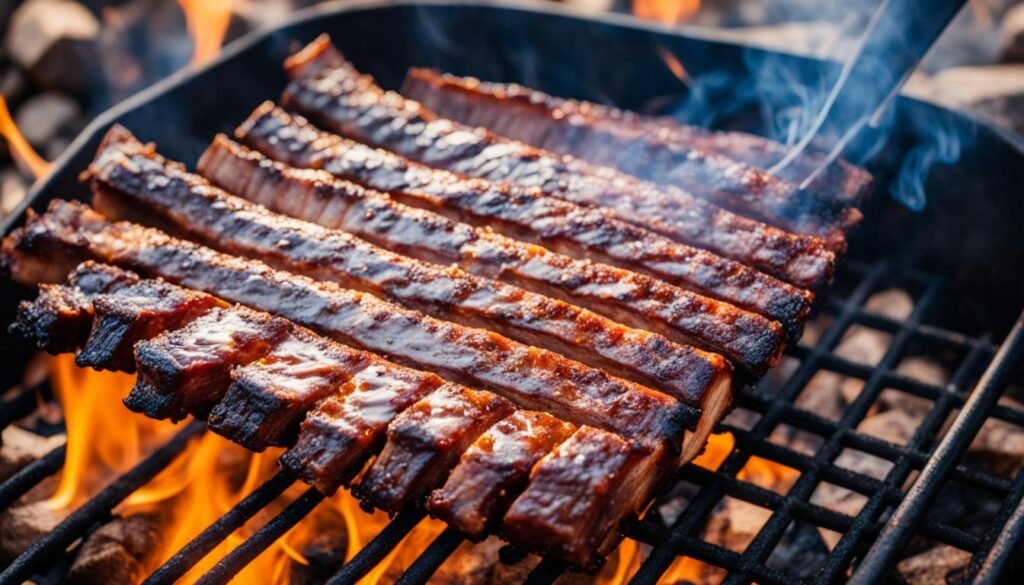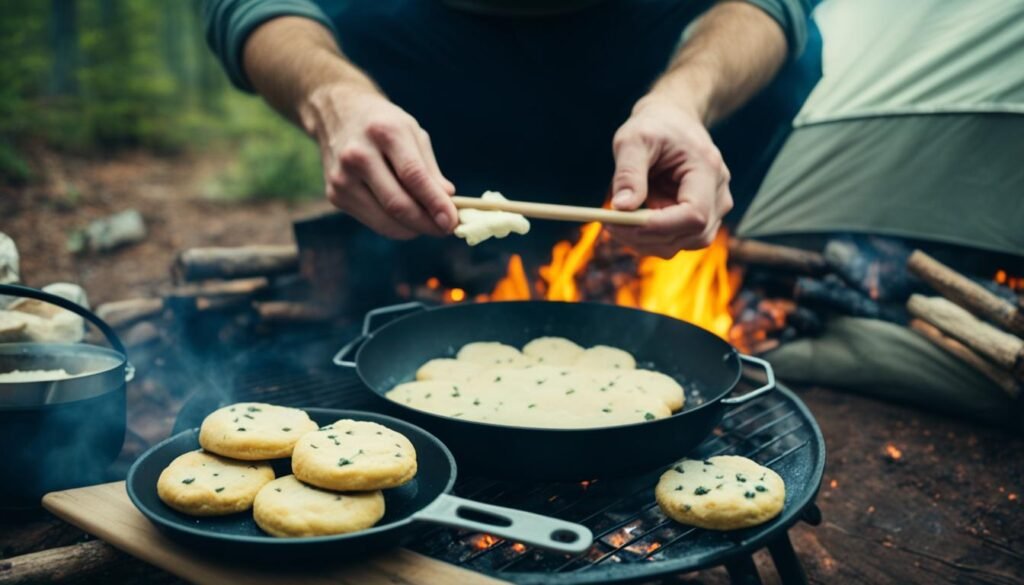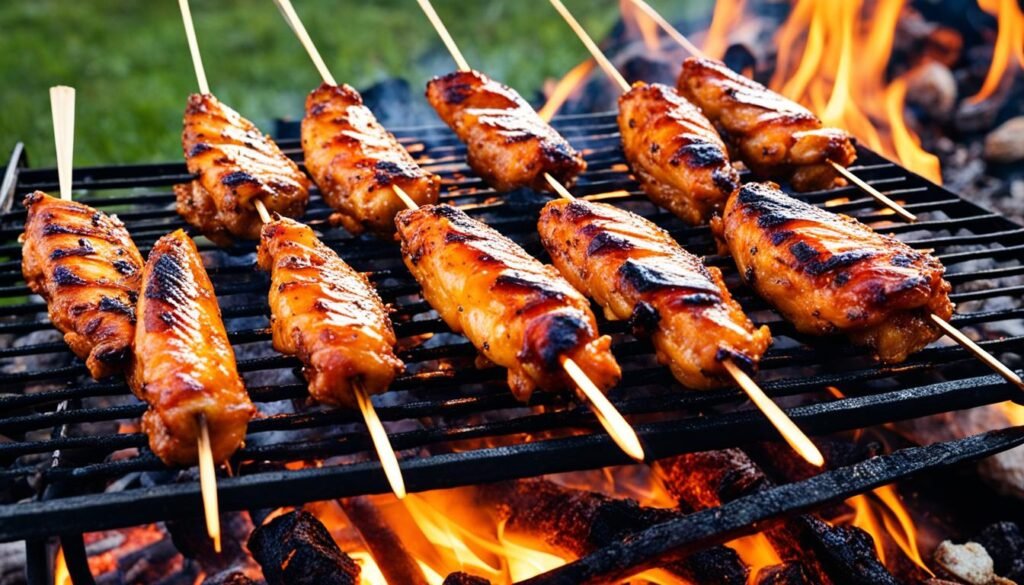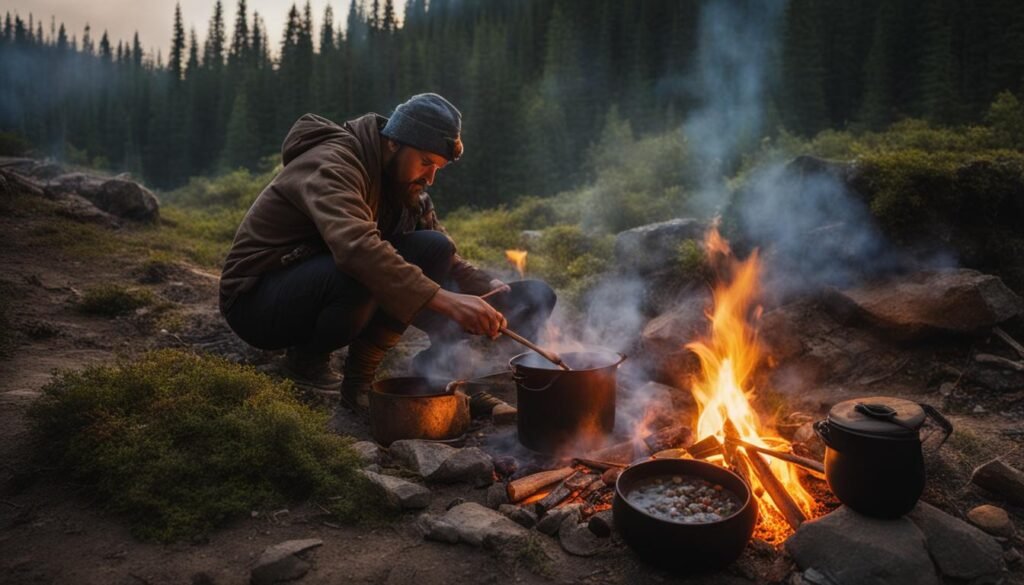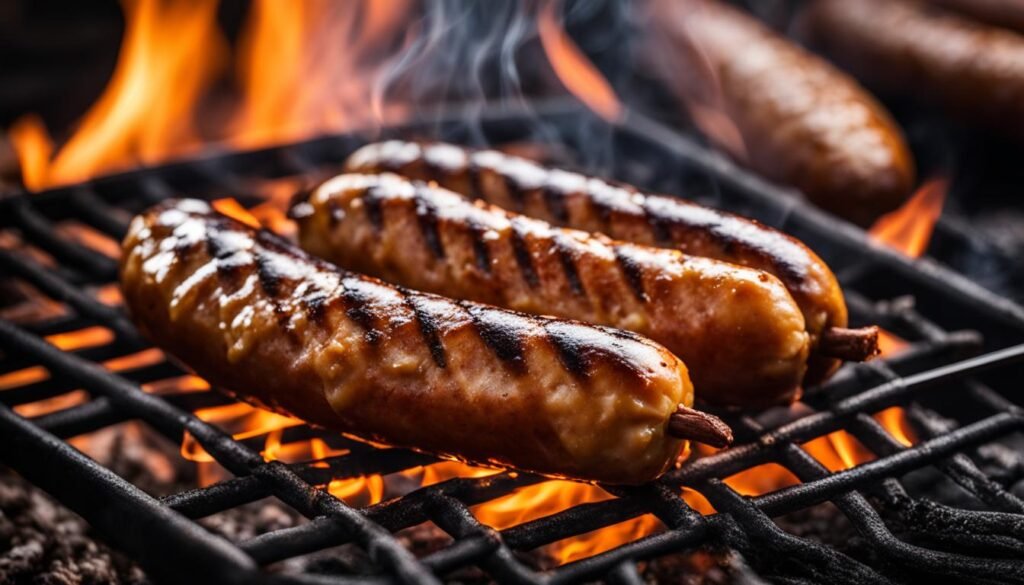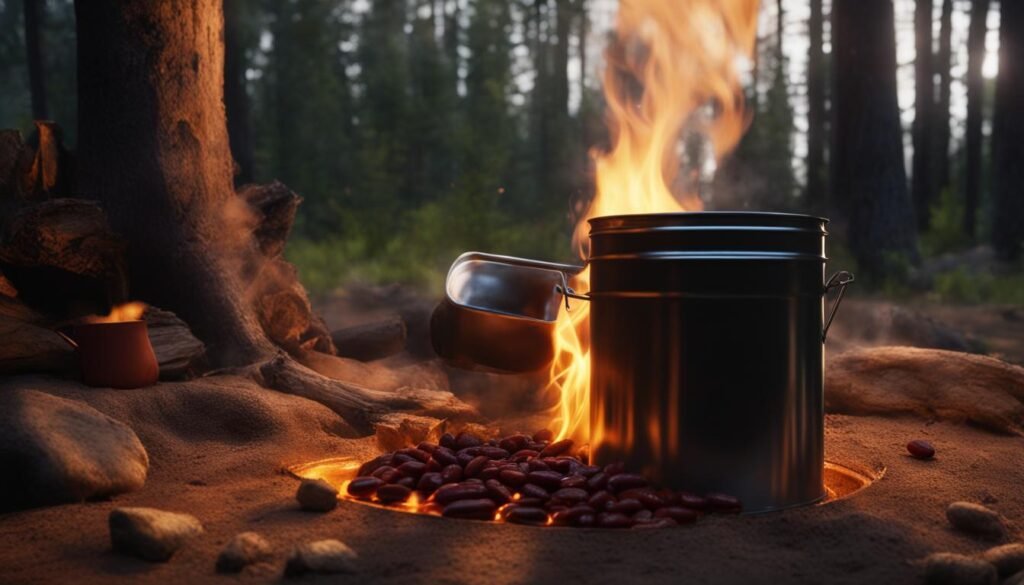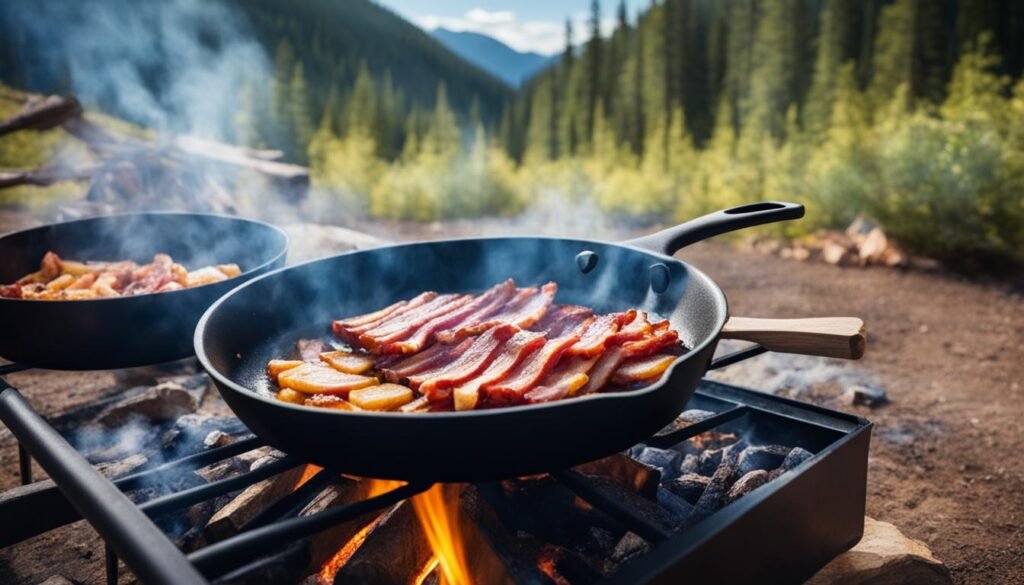There’s nothing quite like the smoky flavor infused into tender, juicy ribs cooked over an open fire. Whether you’re out camping or hosting a backyard BBQ, this recipe is sure to impress your guests. So, let’s get started on creating a memorable outdoor cooking experience!
Key Takeaways:
- Learn how to cook delicious ribs on a campfire for that perfect smoky flavor.
- Impress your guests with tender, juicy ribs using an easy-to-follow recipe.
- Prepare your ribs with a flavorful marinade for maximum taste.
- Grill the ribs over a campfire to infuse them with a unique smoky aroma.
- Serve your mouthwatering ribs with classic BBQ coleslaw and other tasty sides.
Easy Grilled Ribs for Camping: Grilled Campfire Ribs Recipe
Are you planning a camping trip or a backyard BBQ party? Look no further! This easy grilled campfire ribs recipe is perfect for both occasions. With country-style pork ribs, a flavorful marinade, and the smoky goodness of a campfire, these ribs are guaranteed to impress your guests.
First, start by parboiling the country-style pork ribs on the stove-top. This step helps to tenderize the meat and ensures that it cooks evenly. Once the ribs are parboiled, it’s time to get them marinating.
I recommend using Stubb’s Pork Marinade for an extra kick of flavor. This spicy blend of spices, chiles, lime, and ginger infuses the ribs with a delicious taste that will keep everyone coming back for more. Allow the ribs to marinate for at least 24 hours, allowing the flavors to penetrate the meat and create a mouthwatering combination.
After marinating, it’s time to fire up the grill or get your campfire going. Place the marinated ribs on the grill, allowing them to cook over medium heat. Turn the ribs frequently and baste them liberally with your favorite BBQ sauce. This not only adds moisture but also enhances the flavors and creates a beautiful glaze.
Pro Tip: For an extra smoky flavor, you can also try using wood chips or chunks on the campfire or grill. Hickory and mesquite are great options.
The result? Fall-off-the-bone tender ribs with a caramelized BBQ sauce coating. Be prepared for your guests to devour every last bite.
Why Choose This Recipe for Camping
This grilled campfire ribs recipe is not only delicious but also perfect for camping trips. The parboiling and marinade steps can be done ahead of time, allowing you to marinate the ribs at home before you even set off on your adventure. Once you reach your campsite, all that’s left to do is fire up the grill or campfire and cook the ribs to perfection.
The convenience of this recipe makes it a great option for camping. You can spend less time prepping and more time enjoying the outdoors with your loved ones. Plus, the flavor combination of the tender ribs and the smoky, charred goodness of the campfire will create an unforgettable dining experience.
Whether you’re camping or hosting a backyard BBQ, these easy grilled ribs will be the highlight of your meal. So grab your ingredients, pack up your camping gear, and get ready to indulge in some mouthwatering ribs.
The Benefits of Pre-Cooked Ribs for Camping
When it comes to camping trips, one of the greatest joys is savoring a delicious meal in the great outdoors. However, cooking while camping can often be a challenge, especially when it comes to preparing tender and flavorful ribs. That’s where pre-cooked ribs come in to save the day. By pre-cooking your ribs before your camping trip, you can enjoy an easy and hassle-free dinner that will impress your fellow campers.
Pre-cooked ribs for camping are a game-changer, offering convenience and mouthwatering flavors that will make your camping experience even more enjoyable.
So, what are the benefits of pre-cooked ribs for camping? Let’s dive in:
1. Easy Dinner for Camping
Preparing a delicious dinner while camping can be exhausting, especially after a long day of outdoor activities. With pre-cooked ribs, you can eliminate the stress of cooking from scratch and enjoy an effortless meal. By simply parboiling the ribs before your trip, you can ensure they are tender and ready to be grilled or heated over the campfire.
2. Make-Ahead Rib Recipe
One of the most significant advantages of pre-cooked ribs is that they can be made ahead of time. By marinating the ribs in your favorite BBQ sauce and pre-cooking them, you can ensure that the flavors are infused and the meat is tender. This make-ahead rib recipe allows you to spend more time enjoying nature and less time worrying about preparing dinner.
3. Flavorful and Tender Ribs
Pre-cooking the ribs before your camping trip ensures that they are tender and packed with flavor. By parboiling the ribs, you can achieve a perfectly cooked texture that is moist and easily falls off the bone. Additionally, marinating the ribs in BBQ sauce before pre-cooking adds an extra kick of flavor, resulting in a mouthwatering camping dinner.
4. Hassle-Free Camping Meal
When you’re out in the wilderness, the last thing you want is complicated meal preparations. Pre-cooked ribs offer a hassle-free camping meal option that allows you to focus on enjoying the nature around you. Simply pack your pre-cooked ribs in a portable container, bring them to the campsite, and heat them up over the fire or grill. It’s that easy!
Pre-cooked ribs for camping are a game-changer, making your camping trip more enjoyable and stress-free. With their convenience and delicious flavors, they are a must-have for any outdoor enthusiast.
So, next time you plan a camping adventure, consider pre-cooked ribs as your go-to meal option. They offer an easy and flavorful solution that will make your camping experience even more memorable.
Tips for Marinating the Ribs
Marinating the ribs is an essential step in this recipe to achieve flavorful and succulent results. For the best flavor infusion, I highly recommend using Stubb’s Pork Marinade. It’s a spicy blend of chiles, lime, and ginger that adds a delicious kick to the ribs.
To marinate the ribs, follow these steps:
- Place the ribs in a large resealable bag or a non-reactive container.
- Pour the Stubb’s Pork Marinade over the ribs, ensuring they are fully submerged in the marinade.
- Seal the bag or cover the container and refrigerate for at least 24 hours. Ideally, marinate the ribs for two days to allow the flavors to penetrate the meat fully.
- During the marinating process, turn the ribs a few times to ensure they are evenly coated with the marinade.
Marinating the ribs for an extended period allows the flavors to develop and infuse every bite. The result is tender and flavorful ribs that will delight your taste buds.
Stubb’s Pork Marinade Ingredients:
| Ingredients | Quantity |
|---|---|
| Chiles | 2 tablespoons |
| Lime juice | 1/4 cup |
| Ginger | 1 tablespoon, minced |
| Other spices and herbs | As per taste |
By following these marinating tips and using Stubb’s Pork Marinade, you can elevate the flavor of your ribs to the next level. The marinade’s spicy blend will add a delightful kick, making every bite a truly tantalizing experience. Don’t rush the marinating process—let the flavors meld and transform your ribs into a mouthwatering masterpiece.
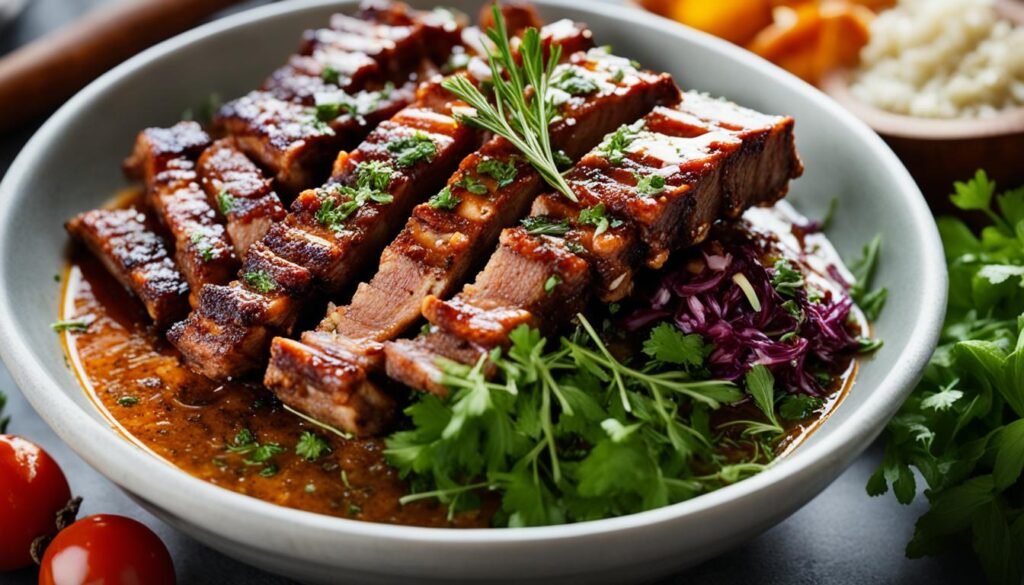
Grilling the Ribs Over a Campfire
Once you have transported the marinated ribs to your campsite, it’s time to grill them over a campfire. The open flame creates a unique cooking experience that enhances the flavor of the ribs, giving them a delicious smoky taste. Follow these campfire cooking tips to ensure perfectly grilled ribs:
- Prepare the campfire: Build a fire using dry firewood, allowing it to burn down to hot coals. This will provide a consistent and even heat for grilling.
- Set up the grill: Place a sturdy grill grate over the hot coals, ensuring it is secure and stable. This will serve as your cooking surface for the ribs.
- Position the ribs: Carefully place the marinated ribs on the grill grate, bone side down. Arrange them in a single layer, ensuring there is enough space between each rib for even cooking.
- Cooking time and temperature: Grill the ribs for 15-20 minutes, turning them frequently to prevent burning. The internal temperature should reach 145°F (63°C) for medium-rare or 160°F (71°C) for medium, ensuring they are safe to eat.
- Baste with BBQ sauce: While grilling, baste the ribs liberally with your favorite BBQ sauce. This will add extra flavor and help to keep the meat moist.
Remember to keep an eye on the ribs as they cook, adjusting the position on the grill and the cooking time as needed. The goal is to achieve a beautiful caramelized crust and tender meat that is cooked to perfection.
Here’s a handy campfire cooking table to help you track the grilling process:
| Grill Time | Temperature | Doneness |
|---|---|---|
| 15-20 minutes | 145°F (63°C) for medium-rare | Tender with a pink center |
| 15-20 minutes | 160°F (71°C) for medium | Truly tender and juicy |
“Grilling ribs over a campfire creates a one-of-a-kind flavor that can’t be replicated. The open flame cooking technique gives the ribs a smoky char and a delicious caramelized crust. It’s an experience that every outdoor cooking enthusiast should try.” – BBQ Grilling Magazine
Serving Suggestions and Menu Ideas
To complete your campfire meal, consider serving the ribs with BBQ coleslaw as a delicious side dish. The combination of tangy coleslaw with smoky ribs is a classic pairing. If you want to offer additional options, you can also include grilled burgers alongside the ribs. A recipe for a buffalo burger with smoky BBQ cream sauce is a great addition to your menu. These menu ideas will ensure that your campfire meal is a hit with your guests.
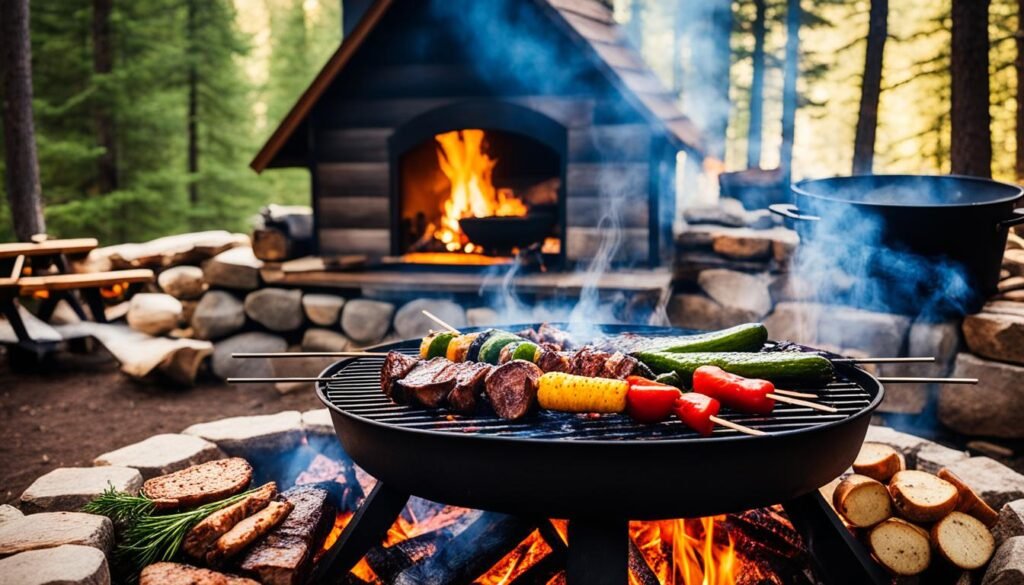
| Menu Ideas | Description |
|---|---|
| 1. BBQ Coleslaw | A tangy and creamy coleslaw made with fresh cabbage, carrots, and a homemade BBQ dressing. The flavors of the coleslaw complement the smoky ribs perfectly. |
| 2. Grilled Burgers | Classic beef burgers grilled to perfection. Serve them with your choice of toppings, such as cheese, lettuce, tomato, and onion. The burgers add variety to your campfire meal. |
| 3. Buffalo Burger with Smoky BBQ Cream Sauce | A unique twist on the traditional burger, the buffalo burger is leaner and has a rich flavor. Top it with a smoky BBQ cream sauce for an extra burst of smoky goodness. |
Exploring Different Rib Recipes
If you’re a fan of country-style ribs, there are many other delicious recipes you can explore. Here are some mouthwatering options to expand your pork repertoire:
1. Slow Cooker Pork Ribs with Potatoes
If you’re looking for a comforting and effortless meal, slow cooker pork ribs are a perfect choice. The ribs are tenderized to perfection in the slow cooker, allowing the flavors to meld together. Serve them with roasted potatoes for a satisfying and hearty dish that requires minimal effort.
2. Brats and Sauerkraut
For a classic combination that the whole family will enjoy, try making brats and sauerkraut. This oven-baked recipe features juicy bratwurst sausages cooked with tangy sauerkraut, creating a harmonious blend of flavors. Serve them on a soft bun with a dollop of mustard for a delicious and fulfilling meal.
3. Spice-Rubbed Pork Tenderloin
If you’re looking to switch things up with a different cut of pork, spice-rubbed tenderloin is a fantastic option. The tenderloin is coated in a flavorful blend of spices, adding a kick of flavor to each bite. Roast it in the oven until perfectly tender, then slice it thinly and serve with your favorite side dishes for a mouthwatering feast.
These diverse pork recipes will allow you to experiment with different flavors and techniques. Whether you prefer the slow-cooked goodness of ribs or the bold flavors of spice-rubbed tenderloin, these recipes are sure to satisfy your cravings.
The Difference Between Baby Back Ribs and St. Louis Style Ribs
When it comes to ribs, there are two popular cuts that often take center stage: baby back ribs and St. Louis style ribs. These rib cuts come from different parts of the ribcage and offer unique flavors and characteristics.
Baby back ribs are known for their small size, lean meat, and tenderness. They are cut from the top of the ribcage near the spine of the hog. Due to their smaller size, they cook relatively quickly and are perfect for those looking for a delicious, melt-in-your-mouth rib experience.
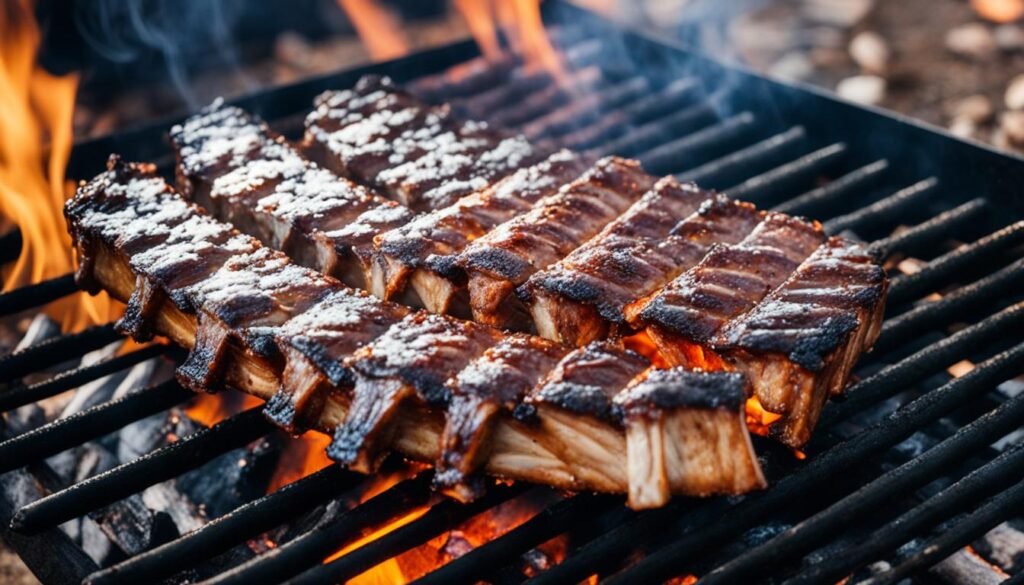
St. Louis style ribs, on the other hand, are meatier and fattier compared to baby back ribs. These ribs are cut from the front or belly section of the hog’s ribcage. The additional fat content adds richness and flavor to the meat, making them a favorite among rib enthusiasts.
Both baby back ribs and St. Louis style ribs have their own unique qualities, which make them suitable for different cooking methods and preferences. Whether you prefer the lean and tender baby back ribs or the meaty and flavorful St. Louis style ribs, both cuts are sure to satisfy your rib cravings.
Differences Between Baby Back Ribs and St. Louis Style Ribs:
| Criteria | Baby Back Ribs | St. Louis Style Ribs |
|---|---|---|
| Size | Smaller | Larger |
| Tenderness | High | Medium |
| Fattiness | Low | High |
| Cut Location | Near the spine | Front/belly section |
The Importance of Cooking to Color and Feel
When it comes to cooking ribs, timing is important, but relying solely on a clock can lead to overcooked or undercooked meat. Instead, I recommend cooking ribs to color and feel, using your senses to gauge their doneness and achieve mouthwatering results. By paying attention to the visual and tactile cues, you can ensure that your ribs are cooked to perfection and avoid the disappointment of overcooked ribs.
One important aspect to consider is the color of the ribs. As you cook them, the surface should develop a dark mahogany color, indicating that a flavorful bark has formed. This bark adds texture and enhances the overall taste of the ribs. Keep an eye on the ribs as they cook and look for this rich, dark color to know that they are on the right track.
However, color alone is not enough. You also need to pay attention to the feel of the ribs. Gently press your finger against the surface of the ribs. They should have a tender shell on the outside, indicating that the meat has cooked to a desirable level of doneness. This tender shell gives way to juicy, tender meat inside, creating a delectable eating experience.
By cooking to color and feel, you can ensure that your ribs are cooked just right, with a perfect balance of flavor and tenderness. Trusting your senses and maintaining a watchful eye will prevent overcooking and help you serve ribs that will make your guests’ taste buds sing.
| Benefits of Cooking to Color and Feel | Avoiding Overcooking Ribs |
|---|---|
| 1. Enhanced flavor: Cooking ribs to color and feel allows for the formation of a flavorful bark on the surface, resulting in a more robust taste. | 1. Juicy and tender: By using this method, you can avoid overcooking the ribs, ensuring that they remain juicy and tender. |
| 2. Perfect texture: The tender shell formed by cooking to feel provides a satisfying texture that complements the succulent meat. | 2. Avoid dryness: Overcooking can lead to dry ribs, but by cooking to color and feel, you can prevent this and serve moist, flavorful ribs. |
| 3. Satisfaction for the senses: Cooking with your senses engages your visual perception and tactile awareness, enhancing your overall cooking experience. | 3. Consistent results: By relying on color and feel, you can achieve consistent results every time you cook ribs, ensuring a delicious outcome. |
So, the next time you’re cooking ribs, remember to trust your senses. Pay attention to the color and feel of the meat, and you’ll be rewarded with perfectly cooked, flavorful ribs that will have everyone asking for seconds.
Troubleshooting Tips for Perfect Ribs
Sometimes, despite your best efforts, you may encounter issues while cooking ribs. Don’t worry, I’ve got you covered with some troubleshooting tips to help you overcome common problems and ensure your ribs turn out perfect every time.
Solutions for Overcooked Ribs
If your ribs have a hard crust, it’s likely that they have been smoked for too long before wrapping. This can result in dry and tough ribs. To prevent overcooking, try adding moisture during the cooking process. You can spritz the ribs with apple juice, cider vinegar, or a water-based mop sauce to keep them moist. Alternatively, using a water pan in your smoker can help maintain the humidity and prevent the ribs from drying out.
Solutions for Tough Ribs
Tough ribs can be disappointing, but fear not! The solution is simple: they just need more cooking time to become tender. If you find that your ribs are tough, continue cooking them until they reach the desired tenderness. You can wrap them in foil and return them to the smoker or grill for additional cooking. The low and slow cooking method will eventually break down the collagen in the ribs, making them beautifully tender.
Solutions for Dry Ribs
Dry ribs can be a result of cooking in a dry climate or overcooking the meat. To add moisture back to your ribs, you can try basting them with a sauce or liquid during the cooking process. Additionally, wrapping the ribs in foil or butcher paper halfway through the cooking time can help retain moisture and prevent excessive drying. Remember, keeping a close eye on the cooking temperature and using a meat thermometer can also help you avoid drying out the ribs.
Solutions for Too Salty Ribs
If your ribs turn out too salty or bland, you can adjust the amount of rub used or try using a different rub altogether. It’s important to strike a balance between the flavors of the rub and the natural taste of the meat. If you find your ribs to be overly salty, you can try reducing the amount of salt or using a rub with less salt content. On the other hand, if your ribs lack flavor, experiment with different rubs to find one that complements the meat and suits your taste preferences.
I hope these troubleshooting tips help you overcome any challenges you may encounter while cooking ribs. With a little adjustment and practice, you’ll soon be able to achieve the perfect set of ribs that are tender, flavorful, and sure to impress your family and friends!
Conclusion
In conclusion, cooking ribs on a campfire can be a rewarding and flavorful experience. By following these tips and techniques, you can achieve succulent and smoky ribs that will impress your guests.
Firstly, marinating the ribs for at least 24 hours is crucial for enhancing their flavor. Whether you choose Stubb’s Pork Marinade or your favorite BBQ sauce, allow the ribs to soak up the deliciousness. This step will ensure that every bite is packed with mouthwatering taste.
Secondly, grilling the ribs over the campfire adds a unique smoky flavor that can’t be replicated. Keep a close eye on the ribs, turning them frequently, and basting them with BBQ sauce for a caramelized, finger-licking glaze. Don’t forget to enjoy the process – inhaling the aroma of the fire and savoring the anticipation of each juicy bite.
Lastly, pay attention to color and feel while cooking the ribs. The dark mahogany color and tender shell indicate that the ribs are perfectly cooked. Trust your senses and make adjustments accordingly to achieve that ideal balance of tenderness and flavor.
FAQ
How do I cook ribs on a campfire?
To cook ribs on a campfire, start by parboiling them on a stove-top and then marinating them in BBQ sauce. After 24 hours of marinating, grill the ribs over the campfire, turning frequently and basting with BBQ sauce.
What type of ribs should I use for campfire cooking?
Country-style pork ribs are recommended for campfire cooking as they are tender and flavorful. They can be easily parboiled and grilled over a campfire or on a grill.
Can I prepare the ribs in advance for camping trips?
Yes, pre-cooked ribs are a great option for camping trips. Parboil the ribs and marinate them in BBQ sauce before your trip. This make-ahead option allows you to transport and cook the ribs easily at the campsite.
How long should I marinate the ribs?
It is recommended to marinate the ribs for at least 24 hours, or ideally, two days. This ensures that the ribs absorb the flavors of the BBQ sauce and become more flavorful.
How do I grill the ribs over a campfire?
Place the marinated ribs on the grill over the campfire and cook them for 15-20 minutes, turning frequently and basting with BBQ sauce. This open flame cooking technique imparts a smoky flavor to the ribs.
What are some serving suggestions for ribs cooked on a campfire?
Consider serving the ribs with BBQ coleslaw as a side dish. Grilled burgers, such as buffalo burgers with smoky BBQ cream sauce, can also complement the ribs well.
Are there other rib recipes I can try?
Yes, there are many other delicious rib recipes you can explore, such as slow cooker pork ribs with potatoes, brats and sauerkraut, and spice-rubbed pork tenderloin.
What is the difference between baby back ribs and St. Louis style ribs?
Baby back ribs are smaller, leaner, and more tender, while St. Louis style ribs are meatier and fattier. Baby back ribs come from near the spine of the hog, while St. Louis style ribs come from the front/belly section.
How do I know when the ribs are cooked?
Cooking to color and feel is important when cooking ribs. The ribs should have a dark mahogany color indicating the formation of a flavorful bark and a tender shell on the outside.
What should I do if my ribs have issues?
If the ribs have a hard crust, they may have been smoked for too long before wrapping. Adding moisture through spritzing or using a water pan in the smoker can help. If the ribs are too tough, they need more cooking time to become tender. Dry ribs can be a result of a dry climate, and adding moisture to the cook can help. Adjusting the amount of rub or using a different rub can solve the problem of ribs being too salty or bland.

